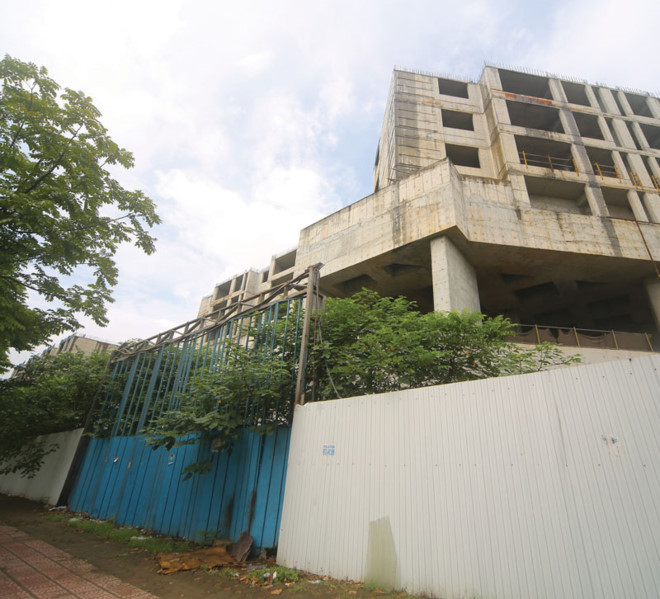Hanoi’s notorious apartment project to be revived?
 |
| Daewoo Cleve has been lying idle for five years to finally show movement |
Daewoo Cleve, developed by Hi Brand Vietnam Company Limited, a subsidiary of South Korean construction company Inpyung, has an investment value of $421 million. The apartments in the project were launched at the end of 2011 at the price of about VND30 million ($1,320) per square metre.
According to the introduction of the developer, the project includes 15 high-rise apartment buildings of 36-40 stories, with areas of about 93-163.1 sq.m of each unit inside. The construction started in October 2010. The developer expected to complete CT2A and CT2B buildings at the end of 2013 and the beginning of 2014, respectively, and the whole 15 buildings were scheduled for completion by 2018.
The project is located at a prime location in Hadong district and is developed by a famous South Korean company. Buyers of the project were also offered attractive sales policies in which they could borrow up to 25 per cent of the apartment value at preferential interest rates. Since January 2012, buyers in the project could also borrow 25 per cent of the apartment value from the developer at 1 per cent a month, or 12 per cent a year, while bank lending rate at that point was 20 per cent a year.
However, the project was launched when the high-end apartment market was in difficulty and amidst financial troubles at the South Korean parent company, so the project ran out of capital. When construction reached the sixth floor at the two buildings at the end of 2012, it stopped and never resumed. In mid-2014, buyers in the project protested because the developer was slow to hand over the apartments as committed.
In July of the same year, Hi Brand Vietnam announced that it would resume construction before December 2014 and hand over apartments to buyers in the fourth quarter of 2016.
In the end, the developer failed to honour these promises. In August 2014, Hi Brand Vietnam asked for permission of the Hanoi People’s Committee to decrease the number of stories and received authorisation in September. People thought the developer would resume the project, but then the company removed all the machinery from the construction site and stopped all activities.
When the Hanoi real estate market recovered at the end of 2014 and grew more in 2015-2016, many projects resumed construction. Daewoo Cleve was not one of them.
In May this year, CEN Group subsidiary Century Real Estate Investment and Development Joint Stock Company (CENInvest) and Hi Brand Vietnam out of the blue announced signing a cooperation agreement on developing The K-Park Hadong project. This project has three high-rise apartment buildings of 23, 25, and 27 stories with a common basement.
Pham Thanh Hung, deputy chairman of CEN Group, said this is a part of the Daewoo Cleve project that CEN Group bought from Hi Brand. At the same time, Hi Brand announced the La Casta detached housing project with 359 low-rise houses, including 199 shophouses. This new project is another part of the Daewoo Cleve project.
Real estate agents said in case CENInvest successfully implements the three buildings of The K-Park, it will consider buying further parts of the suspended Daewoo Cleve.
CENInvest is residential property developer in the north and south of Vietnam, including Thang Long Garden, CT2A, HHB Tan Tay Do, Helios Tower, Park View Residence, The Golden Palm (Hanoi) or the Le Thanh apartment building in Ho Chi Minh City.
Whether CENInvest will be able to revive Daewoo Cleve remains to be seen.
“Projects that have been on hiatus for a long time often have deep problems. Maybe the product is not correctly targeted and it cannot be changed. Maybe there are a lot of debts to banks or old customers, or the old developer has low capacity,” commented a manager at a real estate developer that recently revived a project on Pham Hung Street of Hanoi. “Therefore, the new investor has to solve these problems from the root. That is the only way to ensure liquidity.”
 |
What the stars mean:
★ Poor ★ ★ Promising ★★★ Good ★★★★ Very good ★★★★★ Exceptional
Latest News
More News
- Sun Group breaks ground on $2 billion Van Don casino complex (December 19, 2025 | 18:14)
- Rare, beautiful, sustainable: the mark of iconic real estate (December 19, 2025 | 08:00)
- Owner-occupied housing stabilises, paving the way for new growth cycle (December 18, 2025 | 17:04)
- Unlocking urban potential of smart cities (December 18, 2025 | 16:50)
- Green finance offers 'passport' for Vietnamese construction, building materials firms (December 15, 2025 | 08:00)
- Gamuda Land commit long-term investment (December 12, 2025 | 11:49)
- HITC ties up with Evolution to develop AI and hyperscale data centres in Vietnam (December 11, 2025 | 12:09)
- Real estate deals boom via high-profile names (December 08, 2025 | 11:32)
- Industrial segment shaped by M&As (December 08, 2025 | 08:00)
- The Privé sets the benchmark for luxury real estate (December 05, 2025 | 08:28)

















 Mobile Version
Mobile Version